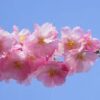**Cherry Blossoms and the Traditional Beauty of South Korea**

Cherry blossoms, known as “beot-kkot” in Korean, hold a special place in the traditional beauty of South Korea. Let’s explore the cultural significance and timeless allure of cherry blossoms in Korean heritage:
1. **Symbol of Renewal and Hope:** In South Korea, cherry blossoms symbolize renewal, new beginnings, and the fleeting nature of life. As the delicate pink petals bloom across the landscape, they herald the arrival of spring and inspire feelings of hope, optimism, and rejuvenation. For centuries, Koreans have celebrated the beauty of cherry blossoms through festivals, poetry, and art, embracing their ephemeral beauty as a metaphor for the cycle of life and the promise of a brighter future.
2. **Cultural and Aesthetic Appreciation:** Cherry blossoms are revered for their exquisite beauty and graceful elegance, which have captivated artists, poets, and admirers throughout Korean history. The soft blush of pink petals against a backdrop of azure skies and verdant landscapes creates a scene of ethereal beauty that has inspired countless works of art, literature, and music. From traditional ink paintings to contemporary digital art, cherry blossoms continue to be a cherished subject of artistic expression and aesthetic appreciation in South Korea.
3. **Historical and Literary Significance:** Cherry blossoms have deep roots in Korean history and literature, with references dating back to ancient times. In traditional Korean culture, cherry blossoms were often associated with the Confucian virtues of humility, integrity, and moral purity, and were featured prominently in classical poetry, folktales, and rituals. Their delicate blooms were also favored by Korean royalty and aristocracy, who incorporated them into courtly ceremonies, garden design, and decorative arts, further enhancing their cultural prestige and symbolic importance.
4. **Seasonal Festivities and Cultural Traditions:** Springtime cherry blossom festivals, known as “beot-kkot festivals,” are eagerly anticipated events in South Korea, drawing millions of visitors from around the world to witness the breathtaking beauty of cherry blossoms in full bloom. These festivals feature a variety of cultural performances, traditional music, dance, and culinary delights, creating a festive atmosphere of joy and celebration. Families and friends gather beneath the flowering cherry trees to enjoy picnics, take photographs, and revel in the splendor of nature’s annual spectacle.
5. **Contemporary Influence and Global Appeal:** In modern-day South Korea, cherry blossoms continue to exert a profound influence on art, fashion, design, and popular culture. From fashion runways to K-pop music videos, cherry blossoms are celebrated as a symbol of youth, romance, and the beauty of fleeting moments. Their timeless appeal transcends borders and cultures, inspiring artists, designers, and travelers around the world to embrace the enchanting charm of cherry blossoms and the rich cultural heritage of South Korea.
In summary, cherry blossoms embody the traditional beauty, cultural richness, and poetic elegance of South Korea’s cultural heritage. As symbols of renewal, hope, and aesthetic appreciation, they continue to captivate hearts and minds, reminding us of the timeless allure of nature’s fleeting beauty and the enduring legacy of Korean artistic tradition.
**Part 2: Cherry Blossoms and the Traditional Beauty of South Korea**
Continuing our exploration of cherry blossoms and their traditional beauty in South Korea, let’s delve deeper into their cultural significance and enduring legacy:
1. **Cultural Symbolism:** In South Korea, cherry blossoms symbolize the beauty of life, transience, and renewal. This symbolism is deeply rooted in Korean culture and is reflected in various aspects of life, including art, literature, and philosophy. The fleeting nature of cherry blossoms serves as a reminder to cherish each moment and find beauty in impermanence.
2. **Aesthetic Inspiration:** Cherry blossoms have long been a source of artistic inspiration in South Korea. Traditional Korean paintings often feature cherry blossom motifs, portraying their delicate beauty and ethereal quality. These paintings, known as “hwarangdo,” capture the essence of springtime in Korea and are cherished for their timeless appeal.
3. **Cultural Festivals:** Springtime in South Korea is marked by vibrant cherry blossom festivals held across the country. These festivals attract visitors from around the world who come to admire the stunning displays of cherry blossoms in full bloom. Festivities include music and dance performances, traditional Korean games, and culinary delights, creating a lively atmosphere of celebration and camaraderie.
4. **Historical Significance:** Cherry blossoms have a rich history in South Korea, dating back centuries. They were often depicted in ancient Korean art and literature as symbols of beauty and purity. During the Joseon Dynasty, cherry blossom viewing parties were popular among the aristocracy, who would gather to appreciate the blossoms and compose poetry inspired by their fleeting beauty.
5. **Cultural Identity:** Cherry blossoms hold a special place in the hearts of Koreans and are considered a national symbol of South Korea. They are often featured in Korean folklore and mythology as symbols of prosperity and good fortune. Today, cherry blossoms continue to be celebrated as a cherished part of Korean culture, representing the resilience and beauty of the Korean people.
In conclusion, cherry blossoms embody the traditional beauty and cultural richness of South Korea. As symbols of renewal and transience, they inspire awe and appreciation among Koreans and visitors alike, serving as a timeless reminder of the beauty of life and the fleeting nature of time.

